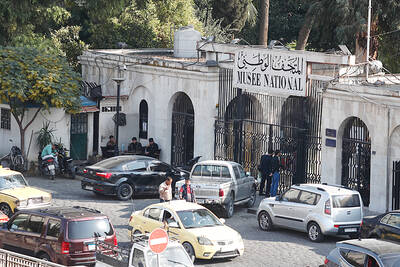It is one of the world’s most famous unsolved codes whose answer could sell for a fortune — but two US friends say they have already found the secret hidden by Kryptos.
The S-shaped copper sculpture has baffled cryptography enthusiasts since its 1990 installation on the grounds of the CIA headquarters in Virginia, with three of its four messages deciphered so far.
Yet K4, the final passage, has kept codebreakers scratching their heads. Sculptor Jim Sanborn, 80, has been so overwhelmed by guesses that he started charging US$50 for each response.

Photo: courtesy of CIA via AP
Sanborn in August announced he would auction the 97-character solution to K4 as he no longer had the “physical, mental or financial resources” to maintain the code.
In a sign of wide interest in Kryptos, which has inspired cultural figures including The Da Vinci Code author Dan Brown, the code’s solution is on course to fetch more than US$240,000 in a sale due to end today.
So when two friends last month announced they had uncovered the last message held by Kryptos (“hidden” in ancient Greek), it invoked fury and concern from the auction house and Sanborn.
Jarett Kobek, a writer from Los Angeles, said the pair came across the code after he noticed a reference to Washington’s Smithsonian Institution, where Sanborn held his archives, in the auction catalog. He asked his friend Richard Byrne, who is based in the US capital, to take a look through the files.
“I took images of all the coding stuff in the files,” said Richard Byrne, a journalist and playwright.
A few hours later, Kobek called him and said: “Hey, you might have found something interesting,” he recalled.
Using Byrne’s photos and clues previously shared by Sanborn, Kobek unraveled the K4 message.
The two men decided to write to Sanborn to share their discovery — but instead of congratulations, they were met by alarm.
Sanborn asked them to sign nondisclosure agreements (NDAs) in exchange for a share of the money raised in the auction, they said.
“The NDA is a total nonstarter,” Kobek said. “You are running an auction where what you are selling is intellectual property exclusivity.”
“If I take money from that sale, I feel like this would almost certainly make me party to fraud,” he said.
They last month went public with their discovery in a New York Times piece.
Sanborn, explaining his communication with the men, wrote in a public letter: “I was trying to save K4 from disclosure by any means possible. I had succeeded for 35 years after all.”
Kobek said the pair were keen to avoid disrupting the K4 auction.
“The last thing anyone wants to do is take money from an 80-year-old artist,” he said.
Even if they have no intention of revealing the code’s solution, the two men said the auction house has sent them cease-and-desist letters.
Sanborn has acknowledged his error in archiving the crucial information — but he downplayed the discovery.
He said the pair had “found and photographed five pieces of scrambled texts that I had accidentally placed in the archive boxes all those years ago.”
“The scrambled plain text was found, but without the coding method or the key. This is a very important distinction,” he separately told a news conference this month.
The discovery does not end the mystery of Kryptos, he added.
K5, with a “similar but not identical” coding system to K4, is also to be released after the current auction sale.

Philippine President Ferdinand Marcos Jr yesterday vowed that those behind bogus flood control projects would be arrested before Christmas, days after deadly back-to-back typhoons left swathes of the country underwater. Scores of construction firm owners, government officials and lawmakers — including Marcos’ cousin congressman — have been accused of pocketing funds for substandard or so-called “ghost” infrastructure projects. The Philippine Department of Finance has estimated the nation’s economy lost up to 118.5 billion pesos (US$2 billion) since 2023 due to corruption in flood control projects. Criminal cases against most of the people implicated are nearly complete, Marcos told reporters. “We don’t file cases for

A feud has broken out between the top leaders of the far-right Alternative for Germany (AfD) party on whether to maintain close ties with Russia. The AfD leader Alice Weidel this week slammed planned visits to Russia by some party lawmakers, while coleader Tino Chrupalla voiced a defense of Russian President Vladimir Putin. The unusual split comes at a time when mainstream politicians have accused the anti-immigration AfD of acting as stooges for the Kremlin and even spying for Russia. The row has also erupted in a year in which the AfD is flying high, often polling above the record 20 percent it

Ecuadorans are today to vote on whether to allow the return of foreign military bases and the drafting of a new constitution that could give the country’s president more power. Voters are to decide on the presence of foreign military bases, which have been banned on Ecuadoran soil since 2008. A “yes” vote would likely bring the return of the US military to the Manta air base on the Pacific coast — once a hub for US anti-drug operations. Other questions concern ending public funding for political parties, reducing the number of lawmakers and creating an elected body that would

‘ATTACK ON CIVILIZATION’: The culture ministry released drawings of six missing statues representing the Roman goddess of Venus, the tallest of which was 40cm Investigators believe that the theft of several ancient statues dating back to the Roman era from Syria’s national museum was likely the work of an individual, not an organized gang, officials said on Wednesday. The National Museum of Damascus was closed after the heist was discovered early on Monday. The museum had reopened in January as the country recovers from a 14-year civil war and the fall of the 54-year al-Assad dynasty last year. On Wednesday, a security vehicle was parked outside the main gate of the museum in central Damascus while security guards stood nearby. People were not allowed in because